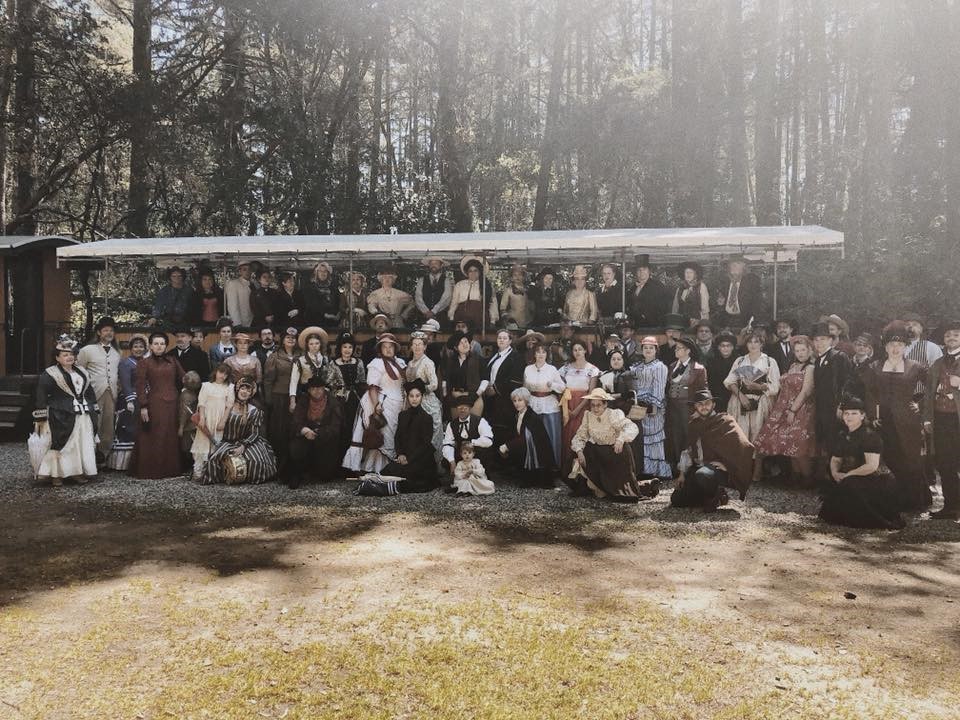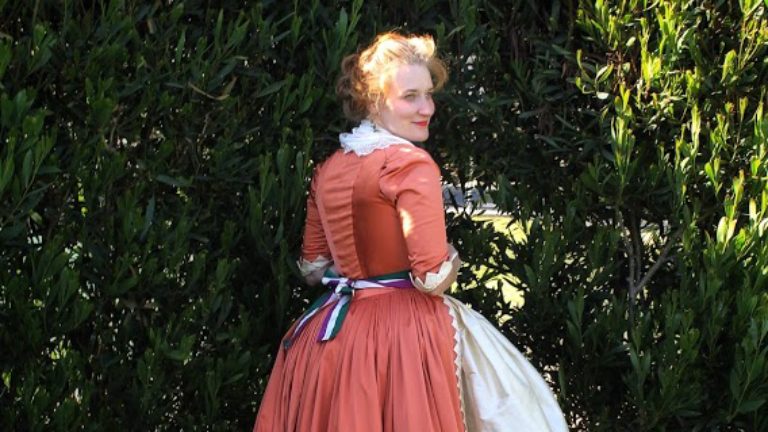How to Be the Best Costumer You Can Be

by Vivien Lee
This article isn’t about how to sew, put together an outfit, or win a competition. It’s about how to be the best version of yourself at an event. If you are new to the GBACG, welcome! If you are an old-timer, thank you for your participation in making our club what it is today. Either way, read on for some suggestions on how to maximize enjoyment at a GBACG event by practicing good costume manners and by being kind to others and yourself.
Be aware that all skill levels are welcome.
GBACG is not a reenactment group, but a social club that puts on events for time travelers. Historical accuracy is not required (but absolutely encouraged if that makes you happy!) Self-sewn, store-bought, rented, and thrifted costume are all allowed and present at our events. The following photo is from our Train Ride into the West train event in Felton. Victorian ladies and gentlemen, cowboys and cowgirls, respectable families and outlaws, sporting outfits, steampunks, and more were all present. Whether someone was wearing a full suit and gown, or a skirt and blouse or vest and trousers combo from their closets, everyone was equally welcome and had a good time at our BBQ! (Keep in mind that the GBACG also hosts smaller events, if you are shy around large crowds).

Remember that authenticity goals vary.
As mentioned above, all skill levels are welcome, and everyone has their own standards. Maybe they are a serious historian, or maybe they just want to come out and play for a day. You may only hand-sew everything in period-correct fabrics such as silk and wool. However, some people may machine-sew in natural fibers or synthetic ones due to time, budget, or personal preference. Someone might have hot-glued an outfit together because they heard about an event last-minute. None of this is “wrong.” Everyone has a different goal, and don’t assume theirs is the same as yours.
Don’t offer unsolicited advice.
Would you approach a stranger on the street and tell them their shoes don’t go with their outfit, or that their jewelry is wrong? Hopefully not. So, why would you do that at an event? (Telling someone nicely that their skirt is flipped up and their petticoat is showing is a different matter; that should be welcomed because it is something that can be fixed right away).
Ask yourself if your “helpful” comments are really helpful.
You may think you’re giving constructive criticism, but please consider carefully if it is 1) wanted by the recipient and 2) whether it could be interpreted as condescending. Here are some examples where the speaker may be well-intentioned, but their comments could be found hurtful to a newcomer or sensitive person:
- “I don’t know why you wouldn’t want to take a little extra time to look so much better by doing XYZ.”
- “Oh yeah, I used to wear stuff like that too when I was new. You’ll learn.”
- “I prefer to costume at a higher caliber but I guess you can do what you want.”
- “If you care what others think you should do XYZ.”
If you truly mean to be helpful, consider these examples:
- DO: “Do you want to know where I buy my shoes?”
- DON’T: “Instead of boots like that, you could get accurate ones at this company.”
The first example takes into consideration what the other person wants, and gives them the option to decline. The second example assumes the other person needs and wishes to “improve” and doesn’t have health or funding issues that require them to wear certain footwear. Remember, the GBACG isn’t promoting any particular standard other than fun!
You can always find something nice to say.
Even if it’s not an outfit you’d wear yourself, you can say “What beautiful fabric!” or “That’s a lovely color on you!” If you can’t think of a compliment, ask a question, such as “Did you use a pattern?” or “Have you been here before?” Show an interest in someone you don’t know because communities and hobbies die without new members. Don’t scare anyone away; it will ultimately hurt you in the end.
Don’t touch people without permission.
Good intentions don’t excuse bad behavior, especially when it comes to physical contact. Wanting to compliment someone or take a closer look at their costume does not mean you can touch someone without permission. Because you are a fellow costumer does not mean you are automatically entitled to permission. No means no! Here a some guidelines to follow:
- Remember to ask permission to touch a person, costume, prop, or wig. (And before you do so, ask yourself if you really need to touch at all!)
- Don’t get mad when someone says no, or try to guilt them into changing their mind.
- Don’t assume that because you saw someone else (who may be a close friend) touch a particular costumer or their costume that you should be allowed to as well.
- If you are allowed to examine some fabric on a person’s body, touch their arm and not a private area. Don’t squeeze, and don’t put your hand underneath a garment!
Don’t talk about a stranger’s physical attributes.
Please never tell someone it’s “not historically accurate” for someone of their particular ethnicity, gender, disability, age, etc. to participate in or be present at a particular event or time period. Not only is the GBACG is an inclusive organization for people of all backgrounds, it is just plain rude. We are here to play dress up, not be gatekeepers.
Also refrain from assuming that a costume worn by a person of color must be “ethnic” in some way. If you assume wrong, it can be viewed as offensive or awkward! Even if you are well-intentioned, pointing out what makes someone different may alienate them. (You are sending the message that regardless of their friendliness or the beauty of their costume, the first thing you noticed and thought was important to point out was something they have no control over). It is not necessary to make comments such as “It’s rare to see someone in a wheelchair come here; good for you!” A great way to make someone feel welcome is to treat them like everyone else.
Shyness is not snubbing.
If you are new (or not) don’t automatically assume that someone who doesn’t go out of their way to talk to you is trying to exclude you. There are a lot of introverts in the costume community. Someone may be aloof because they are shy, or experiencing sensory overload. Perhaps they are overwhelmed by the number of people they’ve had to meet and greet that day. Just because someone doesn’t engage you in conversation does not mean that they’re trying to be rude. If people aren’t being obviously mean, don’t take it personally.
Don’t put yourself down.
Some of you reading this may not realize it, but there are others that look up to you. They may be brand new or established in the hobby but admire your work. Perhaps you are a friend of theirs, or someone they follow on social media, or just a stranger they met at that event, but you have more influence than you know. Many of us are our own harshest critics and may joke about our work being “trash” but others are listening. Imagine how disheartening it would be to think that something you admire and aspire to is “not good enough” for someone you see as a role model, and thus worry your role model may be judging you too. Please be kind to others by being kind to yourself first.
I understand that some people make negative comments about their own projects to avoid seeming snobby, or to keep others from making the same mistakes. There is nothing wrong with taking a compliment gracefully with a simple “Thank you.” If your goal is to be helpful, spin your self-critiques positively.
- DO: “Oh thanks! It’s a good pattern but watch out for the fit on the collar; I found it a little tricky.”
- DON’T: “Oh I can’t believe you like this! My collar looks horrible!”
- DO: “I’m glad you like my cape! I was afraid it wasn’t going to turn out right because I picked a really inexpensive fur that sheds a lot.”
- DON’T: “This cape? Ugh, it is so cheap-looking I’m putting it in the trash when I get home.”
Final thoughts:
The photos below represent my very first and most recent GBACG events. At my first event I had ill-fitting clothes and accessories plus an itchy wig and felt nervous showing up. At my most recent event I was quite happy with how “complete” my outfit was and was delighted to make silly poses with my friends that I met through costuming. The person in the first picture was welcomed warmly at her first event, and encouraged to come back and become the person in the second picture. I am not including these photos as a “see you can improve” before and after but to say: If you are a newcomer, know that you have the right to be shown respect, and to have a good time regardless of what you wear. If you are a veteran member, please remember that we all start somewhere.




John R Schmidt
Dear Ms. Lee:
This is a wonderful article that applies to so many costumed endeavors. I especially enjoy your gentle reminders of better ways to say things. Brava for this!
Regards,
John Schmidt
Trystan
Fabulous article with excellent advice for all. Thank you!
Kerry
The for sharing your valuable thoughts. This could be applied to many hobbyists.
Tamala
Great article, Vivian! And well written! Thank you.
Jerrie Patterson
I have not yet attended a GBACG event….but if you are an example of some of the people who are members, I can hardly wait to meet you all. Your article was thoughtful, grounded and kindly. Thank you for setting a good example. I look forward to the first event I am able to attend.
Anneliese
THIS. You really nailed it, Vivien, while looking fabulous in the 1830s girl gang! Thank you for sharing!
Vivien
Thank you everyone for the feedback. I’m glad you enjoyed the article, and I hope you enjoy your future events!